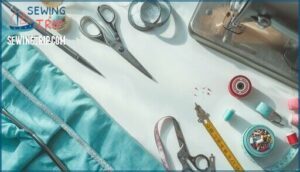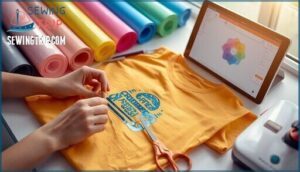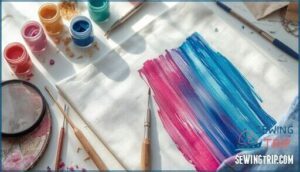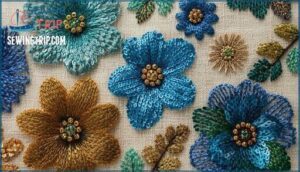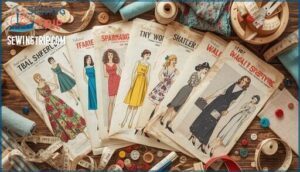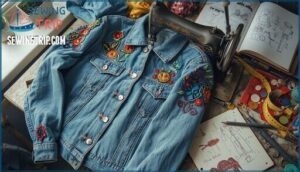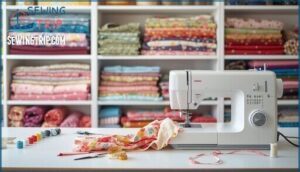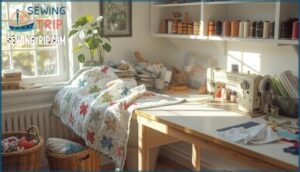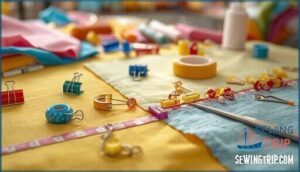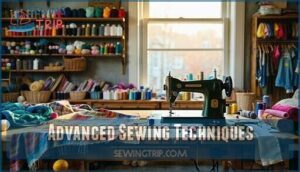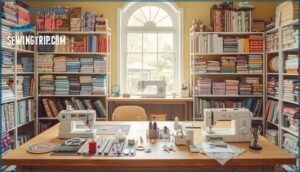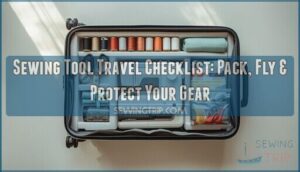This site is supported by our readers. We may earn a commission, at no cost to you, if you purchase through links.
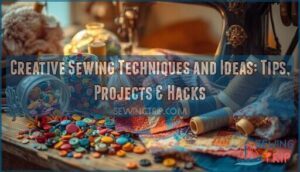 Your grandmother’s button jar probably held more creative potential than most modern craft stores. Those mismatched buttons weren’t just fasteners—they were texture, dimension, and storytelling waiting to happen.
Your grandmother’s button jar probably held more creative potential than most modern craft stores. Those mismatched buttons weren’t just fasteners—they were texture, dimension, and storytelling waiting to happen.
Today’s sewing world has exploded with similar possibilities, from heat transfer vinyl that transforms plain fabric in minutes to embroidery techniques that turn thrift store finds into custom masterpieces.
Whether you’re working with a basic machine or just needle and thread, creative sewing techniques let you push past straight seams and standard patterns. The difference between “homemade” and “I need that” often comes down to a few smart embellishments, unexpected fabric combinations, or clever shortcuts that save time without sacrificing style.
Table Of Contents
Key Takeaways
- Community connection through online forums, YouTube channels, and shared projects accelerates your skill development while opening doors to freelance work, teaching opportunities, and collaborative creative ventures that turn solo sewing into a social craft.
- Strategic embellishment techniques—heat transfer vinyl, embroidery, fabric painting, and decorative trims—transform basic projects into standout pieces, with the key difference between “homemade” and “I need that” often coming down to a few smart finishing touches.
- Matching your needle type and size to your specific fabric (ballpoint for knits, sharp for wovens, heavy-duty for denim) prevents most common sewing frustrations like skipped stitches, puckering, and thread breakage while extending your machine’s lifespan.
- Beginner-friendly projects like tote bags, scrunchies, and table runners build real confidence fast because they teach fundamental techniques—straight seams, hem finishing, strap construction—while creating items you’ll actually use or gift.
Sewing Community Benefits
Sewing doesn’t have to be a solo journey—you’ll find countless opportunities to connect with others who share your passion.
Online communities offer everything from troubleshooting advice to fresh inspiration when you’re stuck on a tricky project.
Here’s where you can jump in and start building connections.
Online Forums and Groups
Where do you turn when your stitch tension baffles you or you want fresh project ideas? Online forums and the sewing community offer instant skill exchange and pattern sharing opportunities that’ll accelerate your growth.
These digital spaces host project showcases where you’ll see real work from sewists at every level, plus group challenges that push your creativity in unexpected directions. With r/Sewing growing to 2.1 million members and forums maintaining active discussions across embroidery and quilting categories, you’re joining a vibrant network built on forum etiquette and genuine support. With over 1.7 million forum posts, members can find solutions to almost any sewing problem.
- Troubleshoot tricky sewing techniques with sewists who’ve solved the same problems
- Swap patterns freely and discover designs you’d never find in stores
- Join group challenges that motivate you to try bold new sewing skills
- Celebrate your wins in project showcases where the community genuinely cheers you on
YouTube Channels and Blogs
Beyond the daily buzz of online forums, YouTube channels and sewing blogs deliver hands-on learning that sticks. Made to Sew averaged 113.8K views per video in 2025, while top blogs like Tilly and the Buttons rank globally for pattern reviews and garment fitting tutorials. You’ll find sewing techniques ranging from basic stitches to complex embellishments, with Channel Engagement rates exceeding 5% among leading creators.
Blog Monetization strategies support free content that keeps Tutorial Trends fresh—think eco fabrics and patchwork revival. These platforms spark real Content Innovation, proving Influencer Impact through sewing tips and hacks that transform your skill set fast. Many sewers find inspiration and resources through popular sewing blogs.
Sharing Work and Career Opportunities
After soaking up inspiration from online forums and YouTube channels, it’s only natural to want to show off your hard work. Sharing your handmade items isn’t just about pride—it’s smart career strategy. Treat your online portfolio as a digital storefront, and you’ll find doors opening to the wider job market. Online networking connects you with freelance sewing gigs, brand partnerships, and teaching roles. For practical next steps, consider:
- Showcasing your best projects online
- Offering sewing classes locally or virtually
- Collaborating with fabric stores
- Selling digital patterns
- Joining skill development groups for feedback
Essential Sewing Tools
Every sewing project starts with the right tools at your fingertips. If you want neat seams and crisp lines, these basics make all the difference.
Here’s what you’ll want on your sewing table.
Fabric Scissors and Rotary Cutters
Ever tried slicing through denim with dull scissors? It’s like cutting steak with a butter knife. Your cutting tools—fabric scissors, rotary cutters, and cutting mats—are the backbone of cutting efficiency.
Ergonomic designs, like wide grips, cut hand fatigue by 17%. Rotary cutters with sharp blade materials (think Japanese SKS-7 steel) glide through layers, boosting precision and sustainability impact. Market trends show electric cutters are on the rise, making fabric cutting faster and easier.
Cotton needs less pressure than denim, so match your blade sharpness to the fabric. For top cutting performance, keep blades fresh and hinges oiled. Your hands will thank you.
Measuring Tape and Clear Ruler
Precision is the heart of great sewing, and your measuring tape and clear ruler are the secret weapons. Flexible measuring tapes—often vinyl-coated fiberglass—bend around curves, meeting industry accuracy standards. Clear acrylic rulers make pattern cutting on your mat a breeze, boosting design functionality and reducing errors. Want reliable results? Here are five essentials:
- Flexible tape for curves
- Acrylic ruler for visibility
- Ruler tape for straight edges
- Both metric and imperial markings
- Washable marking tools
Market trends favor digital upgrades, but classic tools never disappoint.
Sharp Sewing Needles and Iron
With sharp needles and a reliable iron, your sewing jumps from homemade to polished. Needle lifespan matters—replace after 8–16 hours for top stitch quality. Choose needle types and sizes to match your fabric, whether you’re sewing knits or denim.
Iron temperature is key: 110°C for synthetics, 200°C for cotton. Fabric pressing flattens seams and boosts drape.
Regular maintenance tips—clean your iron and inspect machine needles—keep everything running smoothly.
Embellishment Techniques
If you want your sewing projects to stand out, embellishment is where the magic happens. These techniques let you add color, texture, and personality to any piece.
Here are some creative ways to give your work a fresh twist.
Heat Transfer Vinyl Applique
Think of heat transfer vinyl as the magic wand for creative sewing techniques. With HTV applique, you can turn plain fabric into a canvas for vivid designs. Here’s how to get crisp results:
- Use design software for precision.
- Cut your HTV shape.
- Master weeding techniques for clean edges.
- Check fabric compatibility—cotton and polyester work best.
- Apply heat pressing at 325°F for 10-15 seconds.
HTV layering unlocks endless possibilities!
Weeding and Fabric Painting
Ready to add personality to your creative sewing projects? Grab weeding tools—fine-tip hooks or tweezers—for precise vinyl removal and crisp HTV durability.
For fabric painting, go with acrylics on cotton for reliable paint adhesion. Thin coats and transfer methods keep lines sharp.
Textile art thrives on bold design trends, so experiment! These embellishment techniques turn simple fabric into standout pieces with just a few sewing hacks.
Embroidery and Sequin Flowers
Ever wondered how embroidery stitches can turn a plain scrap into a gallery-worthy masterpiece? Dive into sequin flower types—layered petals, beaded centers, and bold mesh—each adding dimension and shine.
With embroidery market trends leaning toward AI embroidery design and sustainable sequin use, you’ll find endless inspiration. Try chain stitches for texture, backstitch for anchoring sequins, and explore free sequin stitch tutorials.
These embellishment techniques improve your creative sewing techniques with just a few thoughtful choices.
Sewing Pattern Options
When you’re picking out your next sewing project, a good pattern can make all the difference. There are plenty of creative options—some nostalgic, others full of color and modern fun.
Here are a few pattern ideas to spark your imagination.
Ruffled Pillowcases and Quilt Patterns
Who knew the humble pillowcase could be a showstopper? With ruffles edging your pillowcases, you don’t just add charm—you master technique and improve everyday home decor.
The real magic lies in Ruffle Density, Fabric Choice, and clever Quilting Integration. Pay attention to quilt design details and draw on current Market Trends, and your bedroom transforms into a gallery of cozy sophistication.
Vintage Doily Table Runners and Placemats
If ruffles bring drama to pillowcases, vintage doilies turn table runners and placemats into conversation starters. Upcycling these treasures means weaving history into your home decor. Try layered doily placement, experiment with asymmetrical designs, and pastel dyeing. Document photo layouts for accuracy, and play with different stitch types for a custom finish.
- Layered doily placement
- Asymmetrical designs
- Pastel dyeing
- Photo layouts for reference
- Varied stitch types
Jelly Roll Rugs and Kids Romper Patterns
Just as vintage doilies breathe life into table runners, jelly roll rugs use forty vibrant fabric strips and zigzag stitches to create bold, textured home accents. These are beginner sewing projects with elevated flair—think market trends and skill level gains. Kids’ romper patterns also shine, especially with grow-with-me features and playful pattern adjustments.
For sewing project ideas that balance project costs and personal style, consider:
- Fabric selection for unique color stories
- Wonder Clips for batting precision
- Custom combinations for standout kids projects
Customization and Design
Customization is where sewing gets personal and creative. You can shape your project with trims, unique touches, and bold design choices.
Here’s how you can bring your own style to life.
Unique Trims and Appliques
With trims and appliques, you can turn basic fabric into something special. Think about trim application—lace on cotton for softness, ribbon on denim for bold contrast. Applique styles like embroidered motifs or fabric scrap flowers add personality. Market trends favor custom embellishment techniques, but watch out for cost factors and quality issues. Here’s a quick guide:
| Trim Type | Creative Twist |
|---|---|
| Ribbon | Layer widths for texture |
| Lace | Dye for custom colors |
| Fringe | Mix with beads |
| Sequin | Edge placement for sparkle |
| Fabric Scraps | Flower appliques |
Pattern Customization and Personalization
Beyond basic trims and appliques, pattern customization lets you craft creating individualized items that truly fit your vision. Digital sizing tools and AI pattern design now make it easier than ever—pattern swaps and online skill development resources help you master fit adjustments like slash-and-spread techniques.
Try AR garment try-on to preview modifications before cutting fabric. Sustainable customization means reusing patterns with fresh design lines, neckline changes, or mixed elements from different templates.
Smart customization and design choices transform ordinary patterns into individualized wardrobe staples.
Mastering Embellishment Techniques
Embellishment techniques expand creative potential by blending traditional craft with modern innovation. Heat transfer vinyl applications and appliqué methods deliver bold, durable designs, while embroidery stitches add intricate detail your projects deserve. Fabric painting lets you customize colors and motifs freely. Smart embroidery systems now adjust thread tension automatically—boosting precision and reducing waste. Decorative trims and beading techniques complete the transformation.
- Embroidery stitches: Try 3D tufting or geometric patterns—these gained 22% in popularity during 2024
- Appliqué methods: Layer repurposed fabrics to cut waste by 18% while creating original designs
- Fabric painting: Combine with appliqué for hybrid embellishment—usage surged 27% among independent designers
- Beading techniques: Crystal and pearl details dominated 37% of 2025 runway styles, perfect for luxury touches
Beginner Sewing Projects
If you’re just starting out, don’t worry—you don’t need years of experience to make something you’ll actually use. These beginner-friendly projects won’t overwhelm you, and they’ll help you build confidence with your machine.
Let’s look at a few simple ideas that’ll get your skills sharp without frustrating you along the way.
Tote Bags and Pillowcases
Starting with tote bags and pillowcases isn’t just smart—it’s the fastest way to build real sewing confidence. These projects teach you straight seams and fabric selection while creating items you’ll actually use.
Experiment with strap design and lining options for durability, or try different closure types like envelope backs or French seams on pillowcases. Pattern hacking lets you tackle size variation using fabric scraps creatively, turning home decor sewing dreams into reality.
| Project | Key Learning Skill |
|---|---|
| Tote Bags | Strap construction and bag structure |
| Pillowcases | Seam finishing and corner techniques |
| Lined Totes | Working with multiple fabric layers |
| French Seam Cases | Professional-looking enclosed seams |
| Scrap Fabric Bags | Creative fabric scraps management |
Scrunchies and Stuffed Paper Hearts
You’ll love sewing scrunchies and stuffed paper hearts—they’re perfect beginner sewing projects that turn fabric scraps into handmade gifts in under an hour. Both accessories embrace fabric scrap reuse while tapping into crafting trends, giving you practical sewing project ideas that blend creativity with sustainability.
Cut a 22×4-inch strip for scrunchies, or punch stitching holes in paper bag hearts for eco-friendly crafts that showcase DIY gift ideas.
Tea-Towel Bread Pouches and Drawstring Pouches
Think of these pouches as your gateway to kitchen textiles—they’re beginner sewing projects that combine function with sustainability. You’ll transform tea towels or linen into drawstring pouches for fresh bread storage, using fabric breathability to extend freshness naturally.
Cut your fabric to size variations that suit baguettes or rolls, then create channels for drawstring options like cotton cord. Seam durability matters here—use zigzag stitches to prevent fraying through repeated washing.
Choose eco-friendly dyes when possible, making these DIY everyday items both practical and planet-conscious easy sewing projects.
Home Decor Sewing
Your home deserves the same creative attention you give to your wardrobe, and sewing opens up a world of practical, beautiful possibilities. From storage solutions to seasonal touches, these projects let you customize your space with fabric choices that match your style.
Here’s how to transform everyday items into something special.
Canvas Log Bags and Floor Runners
Canvas log bags might seem simple, but they’re workhorses that carry serious weight—literally. When you choose heavyweight canvas (around 18 oz. duck canvas works beautifully), you’re tapping into Canvas Durability that handles repeated trips to the woodpile without complaint. Reinforce those grips with sturdy poly webbing and strengthen bottom seams for DIY Construction that lasts seasons.
Floor runners follow similar principles, transforming leftover fabric into Eco-Friendly Canvas home decor with non-slip backing underneath. Design Trends lean toward natural tones and minimalist lines, boosting Market Value for handmade pieces.
- Firewood neatly cradled in sturdy canvas grips
- A runner stretching down your hallway in earthy greens
- Reinforced stitching holding strong under heavy loads
- Custom fabric patterns reflecting your style
- Practical sewing projects doubling as stunning fabric crafts
Rolled Hem Napkins and Duvet Covers
Rolled hem napkins deliver restaurant-quality elegance when you start with 18-inch linen or cotton squares and master a tight rolled edge. You’ll want woolly nylon Thread Choice for Fabric Durability that survives countless dinner parties—most sewers finish each napkin in about 20 minutes using a three-thread serger with 1.0 mm stitch length.
Duvet covers demand precise Size Standards: measure your insert three times, then calculate fabric yardage (roughly 5 yards of 54-inch cotton does a single cover beautifully).
These home textile projects ride current Market Trends toward breathable natural fibers, with Hemming Variations like French seams elevating your home decor from basic to boutique-worthy.
Embroidered Stockings and Pet-Friendly Projects
From polished linens, your sewing machine can jump straight into holiday magic. Embroidered stockings claimed the top spot in 2025’s handmade decor market—custom names and doodle-style motifs drove a 40% search spike. You’ll find AI design software streamlines custom embroidery designs, cutting errors by 15% while you experiment with cotton blends or sustainable fabric choices like organic cotton.
Pet stocking trends mirror this momentum: matching owner-and-pet sets sell for 35% more than solo pieces. Try pet bandanas using tightly woven cotton, or coordinate embroidered stocking designs across your whole household for handmade gifts that spark belonging and community project ideas.
Sewing Tips and Hacks
Sometimes the best sewing solutions come from thinking outside the tackle box. You don’t need expensive gadgets when everyday items can solve common problems in clever ways.
Here are a few simple hacks that’ll make your sewing life easier.
Steel Wool Pin Cushion and Scissor Necklace
With a few smart upgrades, you can keep your sewing tools sharper and closer at hand. Fill a small fabric pouch with fine-grade steel wool to create a pincushion that naturally sharpens your needles as you work—just be sure to use stainless steel wool for rust prevention in humid spaces.
For scissor safety and ergonomic design, thread a 33-inch ribbon or chain through your scissors’ grips to craft a wearable necklace. These sewing techniques extend tool longevity and turn fabric scraps into practical handmade accessories.
Bodkin and Safety Pin Uses
Beyond keeping tools sharp, your bodkin and safety pins are secret weapons for sewing hacks. A bodkin—used in over 90% of sewing workshops—speeds elastic threading through waistbands by 60% less twisting than safety pins alone. Both tools master tube turning for spaghetti straps and handle emergency repairs when seams split.
Vintage bodkins even featured decorative details, proving these sewing techniques blend function with a little flair. For material safety, choose stainless steel options to prevent rust on delicate fabrics.
Hair Straightener and Tape Measure Tips
Your hair straightener isn’t just for styling—its controlled temperatures between 120 °C and 230 °C make it perfect for seam-pressing hacks on cotton and linen. When your iron can’t squeeze into tight spaces around buttons or embellishments, these portable pressing tools shine. Use a press-not-drag technique on narrow hems under 2 cm wide, and you’ll get professional finishes without fabric distortion.
Meanwhile, tape measure accuracy matters more than you’d think. Attach your measuring tape to your cutting table’s edge for fabric measurement tips that save time and reduce errors by up to 15% in dim lighting. Choose dual-scale tapes for international pattern compatibility—they’re game-changers.
These sewing hacks turn everyday items into productivity boosters:
- Temperature control – Set your straightener below 160 °C for synthetics to prevent melting, and always use a press cloth for protection
- Measurement maintenance – Wipe your tape regularly and check that hook movement stays under 0.5 mm for precision cuts
- Smart storage – Keep retractable tapes handy to grab quick measurements without searching through fabric scraps or tangled tools
These sewing techniques blend innovation with practicality, perfect for upcycling projects where every detail counts.
Advanced Sewing Techniques
Once you’ve got the basics down, it’s time to level up your sewing game. Higher-level techniques let you add personality to your projects and work with fabrics in ways that turn simple pieces into something special.
Here’s what you can explore to push your skills further.
Trend-Driven Innovations and Citrus Colors
Citrus textiles are shaking up the sewing world—made from orange peel waste, they feel silky and fight bacteria through twenty washes. Italian brand Orange Fiber transforms 700,000 tonnes of citrus scraps annually into luxury fabric, proving eco-friendly trends can look stunning.
Meanwhile, AI customization platforms like MYCloth let you design one-of-a-kind patterns instantly, while smart sewing machines with wireless connectivity slash production time by 30%.
Pair sustainable dyes from fruit waste with digital sewing tools, and you’ve got creative sewing projects that honor both tradition and innovation—no compromises needed.
Decorative Stitches and Embroidery
Decorative stitches turn plain fabric into art—today’s sophisticated machines include up to 380 preloaded patterns, while handcrafted embroidery still dominates luxury fashion. Machine embroidery delivers precision for custom projects, and sustainable embroidery using organic threads cuts waste by 18%.
Try these embellishment techniques:
- Layer metallic decorative thread over basic stitches for dimension
- Practice French knots on stabilized fabric before tackling complex needlework
- Explore digital embroidery software to customize patterns instantly
Market trends show 67% of DIY projects now feature decorative stitching—your creativity defines the possibilities.
Fabric Transformation and Patchwork
Patchwork ranks as the top upcycling method, slashing fabric waste impact by 50%—the most effective sustainable design approach available. You’ll cut textile waste while tapping into a market growing 12–15% yearly through 2026, driven by consumer trends favoring unique, eco-conscious pieces.
Design evolution now embraces surreal aesthetics over geometric patterns. Transform fabric scraps into creative sewing projects that connect craft heritage with modern innovation—your upcycling methods shape tomorrow’s fashion.
| Patchwork Application | Impact |
|---|---|
| Jeans & accessories | Peak search interest (2x June 2024) |
| Tote bags with QR codes | Enhanced storytelling & engagement |
| Quilting techniques | $1.16B market by 2030 |
| Abstract designs | Retail differentiation leader |
Sewing Project Ideas
Once you’ve got the basics down, it’s time to put your skills to work on projects that actually mean something. Whether you’re stitching up thoughtful gifts, adding handmade touches to your home, or just practicing with beginner-friendly makes, the right project can keep you motivated.
Let’s look at some practical ideas that’ll help you grow your skills while creating things you’ll actually use.
Gift Ideas Like Custom Tote Bags
Custom tote bags blend personality with practicality, making them distinctive handmade gifts. You can transform plain canvas into something special using heat transfer vinyl, embroidery, or appliqué—perfect for showcasing your sewing projects.
DIY Tote Kits simplify the process, letting you focus on Tote Decoration through monograms or fabric painting. Eco-Friendly Gifts resonate with today’s conscious consumers, so consider organic cotton or upcycled materials.
Whether you’re crafting Branded Totes for events or Luxury Totes with premium embellishments like sequins, these thoughtful gifts demonstrate real care. Pair your creation with coordinating fabric packaging for gift ideas that genuinely impress.
Quilted Table Runners and Sewing for Beginners
Quilted table runners are like training wheels for quilting—you’ll build real skills without the commitment of a full-size quilt. Start with beginner patterns requiring just 0.5 to 1.5 yards of fabric, letting you practice Quilting Basics like straight stitching and Binding Methods. These beginner projects teach essential sewing skills while creating beautiful home decor you can actually use.
- Runner Sizing: Standard dimensions work great for skill-building
- Fabric Choices: Cotton prints simplify pattern matching
- Seasonal designs: Autumn themes boost motivation
- Quick completion: Most finish in under 3 hours
Downloadable templates and video tutorials increase your success rate considerably, making quilted table runners ideal first sewing projects.
Choosing The Right Fabric and Machine Needle Selection
Matching your needle to your fabric isn’t just good practice—it’s the difference between smooth seams and frustrating snags. Cotton accounts for roughly 30% of apparel fiber use, while polyester dominates at 52%, so you’ll work with both constantly. Here’s your quick-reference guide for Needle-Fabric Pairing:
| Fabric Type | Needle Size | Thread Compatibility |
|---|---|---|
| Silk, chiffon | 60/8–70/10 | Fine polyester thread |
| Cotton, rayon blends | 80/12–90/14 | All-purpose polyester |
| Denim, canvas | 90/14–110/18 | Heavy-duty, Tex 69 nylon |
| Knit fabric, jersey | 70/10–90/14 ballpoint | Stretch polyester |
| Leather, suede | 100/16–110/18 | Monofilament or nylon |
Needle types matter too—ballpoint needles slip between knit fibers without snagging, while sharp needles pierce woven fabrics cleanly. Your machine needle should cradle the thread snugly in its front groove; mismatched sizing causes thread stripping and “bird nesting.” Most home machines max out at 110/18, creating machine limitations for super-heavy projects.
Replace needles every 6–8 hours of sewing to maintain stitch quality—dull needles wreck both fabric and your machine’s motor.
Frequently Asked Questions (FAQs)
How do you fix common sewing machine problems?
Your machine throwing a fit? Start with tension—incorrect threading through those tension disks causes most problems. Swap your needle (bent ones cause 80% of skipped stitches), vacuum the bobbin area for lint, and rethread everything carefully.
Match your needle size to fabric weight, and you’ll dodge most drama.
What are the best fabric storage solutions?
File cabinets with separators and clear storage boxes are smart choices, but don’t forget climate control—keeping your space between 68°F to 75°F with 40-57% humidity prevents fabric degradation.
Rolling fabric around comic book boards can boost space optimization by 20-30%, while digital inventory systems cut search time dramatically.
How do you calculate fabric yardage requirements?
Think of fabric yardage like a puzzle—you’re figuring out how all your pattern pieces fit together. Measure each pattern piece, add your seam allowance (usually 5/8 inch), then calculate based on fabric width. Don’t forget shrinkage allowance and extra for pattern repeat matching.
Size variations mean larger garments need more yardage, so check your pattern’s chart. Online calculators make measuring techniques easier for complex sewing projects.
Whats the difference between serger and overlock?
You’ll find that serger and overlock are simply regional terms for the same machine. North Americans say “serger,” while folks in Europe and Australia prefer “overlock.”
Both finish seams by trimming fabric edges while stitching simultaneously using multiple threads.
How do you prevent fabric from fraying?
You’ll prevent fraying by finishing raw edges with pinking shears—those zigzag cuts reduce unraveling by up to 80%. Zigzag stitch seam finishing, serging, or applying fray check liquid seals fibers instantly.
For bias tape or folded hems, secure your seam allowance. Fabric stabilizers work wonders on delicate materials too.
How do you sew with faux leather?
Sewing faux leather on your sewing machine requires a few smart adjustments. Use a leather or denim needle (size 14–16), set your stitch length to 5–4mm, and swap in a Teflon or roller presser foot to prevent sticking and guarantee smooth feeding.
Whats the best way to finish seams?
Your fabric type and garment purpose guide the choice—zigzag or overlock stitches work great for everyday wear, while French seams shine on delicate fabrics.
For maximum seam durability in workwear, flat-felled finishes can’t be beat.
How do I install invisible zippers correctly?
Installing an invisible zipper feels like a secret handshake—once you know the trick, it’s surprisingly simple. Use a specialized invisible zipper foot, stabilize your fabric with interfacing, and stitch close to the coil while it’s unzipped.
The key? Proper seam alignment and topstitching for a smooth finish.
Can you sew stretchy fabrics without puckering?
You can sew stretchy fabrics without puckering by using ballpoint or stretch needles, zigzag stitches, lowered tension settings, and specialized presser feet.
Pre-washing fabric and reducing presser foot pressure also help maintain smooth seams on knit fabric while preserving elasticity.
What tension settings work for thick fabrics?
Thick materials like denim need higher tension—usually 4 to 5 on your sewing machine. For upholstery settings, aim for 5, and leather tension can go up to
Thread weight and needle size also play a crucial role. Heavier thread requires more tension to keep stitches balanced and prevent puckering.
Conclusion
Sure, you could spend another weekend scrolling through perfectly curated feeds, convinced that creative sewing techniques and ideas require a design degree and a bottomless budget. Or you could grab that thrift store find, heat up your iron, and prove that a little fabric paint beats algorithm envy every time.
The truth is, your next favorite piece isn’t waiting in a shopping cart—it’s sitting in your scrap bin, ready for whatever wild combination you’re brave enough to try.
- https://textilelearner.net/fabric-manipulation-techniques/
- http://esiculture.com/index.php/esiculture/article/download/2921/1871/5751
- https://www.datainsightsmarket.com/reports/digital-sewing-machine-1520211
- https://www.linkedin.com/pulse/top-trends-custom-embroidery-2024-ahmedcorporation-plmuf
- https://www.textileschool.com/10937/textile-arts-and-crafts-unleashing-creativity-and-innovation/

